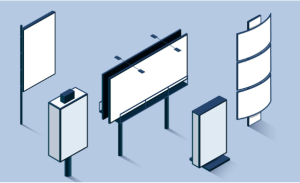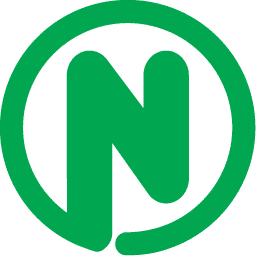What are the Types of Signages?
There are many types of signages, depending on the function, location, material, or style. Some common types of signages are:
Based on Function
- Advertising Signs: These signs are designed to promote products, services, offers, or events to attract attention and generate interest. They usually have catchy slogans, images, or logos that appeal to the target audience. Examples of advertising signs are banners, billboards, posters, and neon signs.
- Branding Signs: These signs are designed to reinforce the identity, values, and personality of a business or organization. They usually have the name, logo, slogan, or color scheme of the brand that creates recognition and loyalty. Examples of branding signs are storefront signs, logo signs, and awning signs.
- Directional Signs: These signs are designed to guide customers or visitors to a specific location or destination. They usually have arrows, symbols, or words that indicate the direction or distance. Examples of directional signs are wayfinding signs, road signs, and parking signs.
- Informational Signs: These signs are designed to provide useful or relevant information, such as opening hours, contact details, prices, or policies. They usually have clear and simple language that is easy to read and understand. Examples of informational signs are menu signs, price tags, and policy signs.
- Persuasive Signs: These signs are designed to influence customer behavior, such as encouraging them to buy, sign up, or take action. They usually have persuasive language, images, or calls to action that motivate the customer. Examples of persuasive signs are special offer signs, testimonial signs, and point-of-purchase signs.
Based on Location
- Indoor Signs: These signs are located inside a building or premises and are usually intended for customers or visitors who are already inside. They can serve various functions, such as advertising, branding, directional, informational, or persuasive. Examples of indoor signs are wall signs, window decals, floor graphics, and digital screens. This will help you to choose the best Types of Signage.
- Outdoor Signs: These signs are located outside a building or premises and are usually intended for customers or potential customers who are passing by. They can serve various functions, such as advertising, branding, directional, informational, or persuasive. Examples of outdoor signs are pole signs, monument signs, sidewalk boards, and yard signs.This will help you to choose the best Types of Signage.
Based on Material
- Acrylic Signs: These signs are made of clear, translucent, or colored thermoplastic that is often used as a lightweight or shatter-resistant alternative to glass. They can be cut into various shapes and sizes and can be illuminated from behind for a glowing effect. Examples of acrylic signs are logo signs, directory signs, and office signs.
- Aluminum Signs: These signs are made of a lightweight metal that is durable and resistant to corrosion and rust. They can be painted or printed with various colors and designs and can be mounted on various surfaces. Examples of aluminum signs are street signs, parking signs, and real estate signs.
- Corrugated Plastic Signs: These signs are made of a lightweight and inexpensive material that is composed of two flat sheets with a fluted core. They can be printed with various colors and designs and can be used for temporary or short-term applications. Examples of corrugated plastic signs are yard signs, election signs, and event signs.
- PVC Signs: These signs are made of a rigid and durable plastic that is suitable for indoor or outdoor applications. They can be printed with various colors and designs and can be cut into various shapes and sizes. Examples of PVC signs are menu boards, trade show displays, and directional signs.
- Vinyl Signs: These signs are made of a flexible and adhesive material that can be printed with various colors and designs and can be applied to various surfaces, such as glass, metal, wood, or plastic. Examples of vinyl signs are window decals, vehicle wraps, and banners.
Based on Style
- Carved Signs: These signs are made by carving letters or graphics into a solid material, such as wood, metal, or foam. They can create a three-dimensional effect and a rustic or elegant look. Examples of carved signs are wooden signs, metal plaques, and foam letters.
- Channel Letters: These signs are made by forming three-dimensional letters or shapes from metal or plastic. They can be illuminated from within or from behind for a glowing effect. Examples of channel letters are storefront signs, logo signs, and mall signs.
- Digital Signs: These signs are made by using electronic displays, such as LED, LCD, or projection, to show images, videos, or text. They can be updated easily and remotely and can show dynamic and interactive content. Examples of digital signs are digital billboards, digital menu boards, and digital kiosks.
- Neon Signs: These signs are made by using neon gas or LED lights to create bright and colorful effects. They can create a retro or modern look and can attract attention at night. Examples of neon signs are bar signs, open signs, and art signs.
What are Signages and Why Do They Matter?
Signages are visual displays that communicate information to customers or potential customers. They can be found in various places, such as storefronts, roadsides, billboards, walls, windows, vehicles, or even online. Signages can have different functions, such as:
- Advertising: Signages can promote products, services, offers, or events to attract attention and generate interest.
- Branding: Signages can reinforce the identity, values, and personality of a business or organization.
- Directional: Signages can guide customers or visitors to a specific location or destination.
- Informational: Signages can provide useful or relevant information, such as opening hours, contact details, prices, or policies.
- Persuasive: Signages can influence customer behavior, such as encouraging them to buy, sign up, or take action.
Signages are important for businesses because they can help them achieve various goals, such as:
- Increase visibility: Signages can make a business stand out from the competition and catch the eye of potential customers.
- Increase awareness: Signages can increase the recognition and recall of a business name, logo, slogan, or product.
- Increase communication: Signages can convey messages that are clear, concise, and compelling to the target audience.
- Increase engagement: Signages can create a positive impression and emotional connection with customers or potential customers.
- Increase conversion: Signages can motivate customers or potential customers to take the desired action, such as visiting a store, making a purchase, or contacting a business.

How to Create Effective Signages for Your Business
Creating effective signages for your business requires careful planning and execution. Here are some steps to follow:
- Define your target audience: Who are you trying to reach with signage? What are their needs, preferences, and expectations? How can you appeal to them?
- Define your location: Where will you place your signage? What are the physical characteristics and limitations of the space? How visible and accessible will your signage be?
- Define your purpose: What do you want to achieve with your signage? What is the main message or call to action you want to convey?
- Define your message: What information do you want to communicate with your signage? How can you make it clear, concise, and compelling? How can you use words that people would use to look for your content?
- Define your design: How will you present your message visually? What colors, fonts, images, shapes, and sizes will you use? How will you balance the elements of contrast, alignment, repetition, and proximity?
- Define your budget: How much money do you have to spend on your signage? What are the costs of materials, production, installation, and maintenance?
To create effective signages for your business, you should also follow the principles of helpful, reliable, and people-first content, as recommended by Google1. This means that your signage should:
- Provide original, relevant, and comprehensive information that is beyond the obvious
- Provide insightful analysis or interesting information that adds value and originality
- Provide a descriptive, helpful summary of the content in the main heading or page title
- Provide clear sourcing, evidence of expertise, and background information about the author or the site that publishes it
- Provide a great page experience that is fast, secure, mobile-friendly, and easy to navigate
- Focus on benefiting people, not gaining search engine rankings
- Avoid copying or rewriting other sources without adding substantial value
- Avoid exaggerating or being shocking in nature
- Avoid creating search engine-first content that is stuffed with keywords or irrelevant links
Related Questions and Answers
Here are some related questions and answers that people might have about signages:
| Question | Answer |
| How to choose the right types of signage for your business? | Choosing the right types of signage for your business depends on several factors, such as: – Your target audience: You should choose a type of signage that appeals to your potential customers and matches their needs, preferences, and expectations. – Your location: You should choose a type of signage that suits the physical characteristics and limitations of the space where you want to place it. You should also consider the visibility and accessibility of your signage from different angles and distances. – Your purpose: You should choose a type of signage that aligns with your goal and message. You should also consider the function and style of your signage, whether it is advertising, branding, directional, informational, or persuasive. – Your budget: You should choose a type of signage that fits your budget and offers a good return on investment. You should also consider the costs of materials, production, installation, and maintenance of your signage. |
| How to measure the effectiveness of your signage? | Measuring the effectiveness of your signage can be challenging, but there are some ways to do it, such as: – Tracking the number of impressions or views that your signage generates. You can use tools like cameras, sensors, or analytics software to measure how many people see your signage and for how long. – Tracking the number of conversions or actions that your signages generate. You can use tools like coupons, codes, QR codes, or surveys to measure how many people take the desired action after seeing your signages, such as visiting your store, making a purchase, or contacting you. – Tracking the feedback or satisfaction that your signages generate. You can use tools like reviews, ratings, comments, or testimonials to measure how satisfied your customers are with your signage and how they affect their perception of your brand. |
| How to maintain and update your signages? | Maintaining and updating your signages are important to keep them fresh and relevant. You should do the following: – Clean your signages regularly to remove dust, dirt, or stains that may affect their appearance or readability. – Repair your signages promptly if they are damaged or broken due to weather, vandalism, or accidents. – Replace your signages periodically if they are worn out or faded due to aging or exposure to sunlight. – Update your signages frequently if they contain information that changes over time, such as prices, offers, or events. – Test your signages periodically if they contain electronic components, such as lights, screens, or sensors, to ensure that they are working properly and safely. |
| Key Takeaways from Types of Signages |
| – Signages are visual displays that communicate information to customers or potential customers. |
| – Signages can be classified into different types based on their function, location, material, or style. |
| – Signages can help businesses attract attention, increase brand awareness, convey messages, and influence customer behavior. |
| – Signages should follow the principles of helpful, reliable, and people-first content, as Google recommends. |
